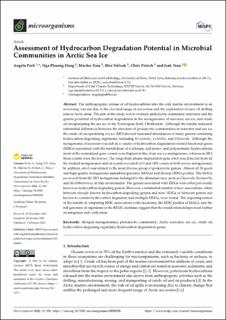| dc.description.abstract | The anthropogenic release of oil hydrocarbons into the cold marine environment is an increasing concern due to the elevated usage of sea routes and the exploration of new oil drilling sites in Arctic areas. The aim of this study was to evaluate prokaryotic community structures and the genetic potential of hydrocarbon degradation in the metagenomes of seawater, sea ice, and crude oil encapsulating the sea ice of the Norwegian fjord, Ofotfjorden. Although the results indicated substantial differences between the structure of prokaryotic communities in seawater and sea ice, the crude oil encapsulating sea ice (SIO) showed increased abundances of many genera-containing hydrocarbon-degrading organisms, including Bermanella, Colwellia, and Glaciecola. Although the metagenome of seawater was rich in a variety of hydrocarbon degradation-related functional genes (HDGs) associated with the metabolism of n-alkanes, and mono- and polyaromatic hydrocarbons, most of the normalized gene counts were highest in the clean sea ice metagenome, whereas in SIO, these counts were the lowest. The long-chain alkane degradation gene almA was detected from all the studied metagenomes and its counts exceeded ladA and alkB counts in both sea ice metagenomes. In addition, almA was related to the most diverse group of prokaryotic genera. Almost all 18 goodand high-quality metagenome-assembled genomes (MAGs) had diverse HDGs profiles. The MAGs recovered from the SIO metagenome belonged to the abundant taxa, such as Glaciecola, Bermanella, and Rhodobacteracea, in this environment. The genera associated with HDGs were often previously known as hydrocarbon-degrading genera. However, a substantial number of new associations, either between already known hydrocarbon-degrading genera and new HDGs or between genera not known to contain hydrocarbon degraders and multiple HDGs, were found. The superimposition of the results of comparing HDG associations with taxonomy, the HDG profiles of MAGs, and the full genomes of organisms in the KEGG database suggest that the found relationships need further investigation and verification. | |
